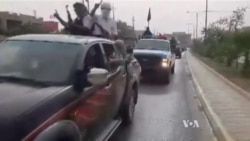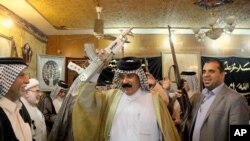PENTAGON —
U.S. military planners are drawing up options to present to President Barack Obama to “break the momentum” of the Islamic State of Iraq and the Levant, also known as ISIL, as its fighters push toward Baghdad.
Pentagon officials say they have been concerned about growing unrest in Iraq for months, and have been rushing more arms and ammunition to the Iraqi military.
Still, the way ISIL was able to march into cities like Mosul with little or no resistance from Iraqi government forces took them by surprise. At a briefing Friday, Pentagon spokesman Rear Admiral John Kirby expressed frustration with Iraq's performance.
Watch related video by VOA's Meredith Buel:
“We’re certainly, you know, certainly disappointed in the performance of some of these [Iraqi] units and I think it’s fair to say that we didn’t expect for them, for those units, to not to have stood up to the threat,” he said.
Kirby refused to endorse the Iraqi military’s ability to withstand a further assault that could target the Iraqi capital.
“I’ll let Prime Minister Maliki speak for his forces and their capability in and around Baghdad.”
For now, the Pentagon says it has increased surveillance and reconnaissance missions over Iraq, using possibly both drones and manned flights.
Even though President Obama has ruled out putting any troops on the ground, defense officials say other assets are nearby, including the aircraft carrier USS George H.W. Bush and a cruiser, which had been in the North Arabian Sea and two naval destroyers operating in the Persian Gulf.
Some analysts warn that it could be a mistake if the U.S. acts only in coordination with the Iraqi government.
The Washington Institute’s Michael Eisenstadt says what's going on in Iraq is a regional problem.
“We have to start thinking of Iraq and Syria as a single theater of operations and we can’t have an approach, a policy approach, that focuses only on Iraq.”
Eisenstadt says many of ISIL’s fighters come from Syria and elsewhere, and serve as force multipliers when paired with local militants.
While the Pentagon says it is hard to put a number on just how large the ISIL force is, other analysts say between Iraq and Syria, there could be as many as 12,000 to 13,000 fighters moving across an area largely under their control.
Pentagon officials say they have been concerned about growing unrest in Iraq for months, and have been rushing more arms and ammunition to the Iraqi military.
Still, the way ISIL was able to march into cities like Mosul with little or no resistance from Iraqi government forces took them by surprise. At a briefing Friday, Pentagon spokesman Rear Admiral John Kirby expressed frustration with Iraq's performance.
Watch related video by VOA's Meredith Buel:
“We’re certainly, you know, certainly disappointed in the performance of some of these [Iraqi] units and I think it’s fair to say that we didn’t expect for them, for those units, to not to have stood up to the threat,” he said.
Kirby refused to endorse the Iraqi military’s ability to withstand a further assault that could target the Iraqi capital.
“I’ll let Prime Minister Maliki speak for his forces and their capability in and around Baghdad.”
For now, the Pentagon says it has increased surveillance and reconnaissance missions over Iraq, using possibly both drones and manned flights.
Even though President Obama has ruled out putting any troops on the ground, defense officials say other assets are nearby, including the aircraft carrier USS George H.W. Bush and a cruiser, which had been in the North Arabian Sea and two naval destroyers operating in the Persian Gulf.
Some analysts warn that it could be a mistake if the U.S. acts only in coordination with the Iraqi government.
The Washington Institute’s Michael Eisenstadt says what's going on in Iraq is a regional problem.
“We have to start thinking of Iraq and Syria as a single theater of operations and we can’t have an approach, a policy approach, that focuses only on Iraq.”
Eisenstadt says many of ISIL’s fighters come from Syria and elsewhere, and serve as force multipliers when paired with local militants.
While the Pentagon says it is hard to put a number on just how large the ISIL force is, other analysts say between Iraq and Syria, there could be as many as 12,000 to 13,000 fighters moving across an area largely under their control.











